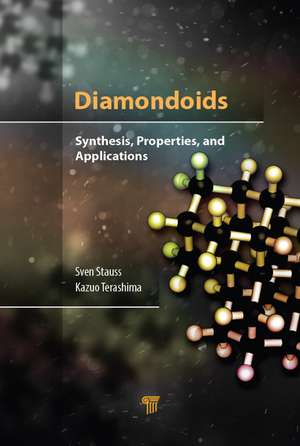Diamondoids: Synthesis, Properties, and Applications
Autor Sven Stauss, Kazuo Terashimaen Limba Engleză Hardback – 21 mar 2017
This book is the first of its kind to give an exhaustive overview of the structures, properties, and current and possible future applications of diamondoids. It contains a brief historical account of diamondoids, from the discovery of the first diamondoid member, adamantane, to the isolation of higher diamondoids about a decade ago. It summarizes the different approaches to synthesizing diamondoids. In particular, current research on the conventional organic synthesis and new approaches based on microplasmas generated in high-pressure and supercritical fluids are reviewed and the advantages and disadvantages of the different methods discussed. The book will serve as a reference for advanced undergraduate- and graduate-level students in chemistry, physics, materials science, and nanotechnology and researchers in macromolecular science, nanotechnology, chemistry, biology, and medicine, especially those with an interest in nanoparticles.
Preț: 565.40 lei
Preț vechi: 757.02 lei
-25% Nou
Puncte Express: 848
Preț estimativ în valută:
108.20€ • 117.49$ • 90.89£
108.20€ • 117.49$ • 90.89£
Comandă specială
Livrare economică 01-15 aprilie
Doresc să fiu notificat când acest titlu va fi disponibil:
Se trimite...
Preluare comenzi: 021 569.72.76
Specificații
ISBN-13: 9789814745185
ISBN-10: 9814745189
Pagini: 258
Ilustrații: 101
Dimensiuni: 152 x 229 x 20 mm
Greutate: 0.54 kg
Ediția:1
Editura: Jenny Stanford Publishing
Colecția Jenny Stanford Publishing
ISBN-10: 9814745189
Pagini: 258
Ilustrații: 101
Dimensiuni: 152 x 229 x 20 mm
Greutate: 0.54 kg
Ediția:1
Editura: Jenny Stanford Publishing
Colecția Jenny Stanford Publishing
Public țintă
Academic and PostgraduateCuprins
Structure and Fundamental Properties of Diamondoids. Applications of Diamondoids. Isolation of Diamondoids from Natural Sources. Synthesis of Diamondoids by Conventional Organic Chemical Synthesis. Synthesis of Diamondoids by Plasmas Generated in High-Pressure Gases and Supercritical Fluids.
Notă biografică
Sven Stauss received an engineering diploma in materials science from the École Polytechnique Fédérale de Lausanne (EPFL), Switzerland, in 2000. After an internship at the R&D center of Toshiba, Japan, from 2000 to 2001, he pursued a PhD in materials science at the EPFL and the Swiss Federal Laboratories for Materials Testing and Research (Empa). After his graduation in 2005, he joined the group of Prof. Terashima in the Department of Advanced Materials Science at the University of Tokyo, Japan, where he is currently assistant professor. His current research focuses on cryoplasmas and plasmas in supercritical fluids and their application to materials processing.
Kazuo Terashima received his ME and PhD in metallurgy and materials science from the University of Tokyo in 1984 and 1988, respectively. From 1993 to 1995, he was a guest professor at the University of Basel, Switzerland. He is now a professor in the Department of Advanced Materials Science, University of Tokyo. His major interest is in plasma materials science. His main research focuses on microplasmas and their application to exotic plasmas, such as supercritical fluid plasmas and cryoplasmas.
Kazuo Terashima received his ME and PhD in metallurgy and materials science from the University of Tokyo in 1984 and 1988, respectively. From 1993 to 1995, he was a guest professor at the University of Basel, Switzerland. He is now a professor in the Department of Advanced Materials Science, University of Tokyo. His major interest is in plasma materials science. His main research focuses on microplasmas and their application to exotic plasmas, such as supercritical fluid plasmas and cryoplasmas.
Descriere
This book is the first to give an exhaustive overview of the structures, properties, current and possible future applications of diamondoids. The first part introduces the structures of diamondoids and gives an overview of their principal chemical and physical properties and a brief historical account, from the discovery of the first diamondoid member to the isolation of higher diamondiods. Then, current synthesis approaches and challenges in obtaining diamondoids in higher quantities are shown. Finally, approaches to generating plasmas in high-pressure and supercritical media are described.
